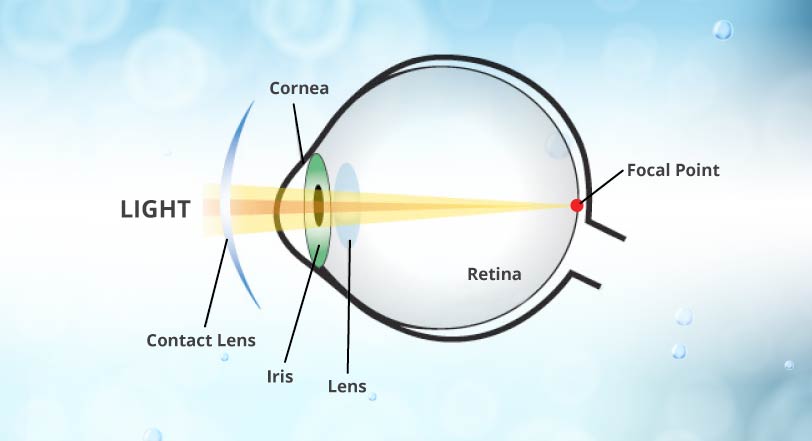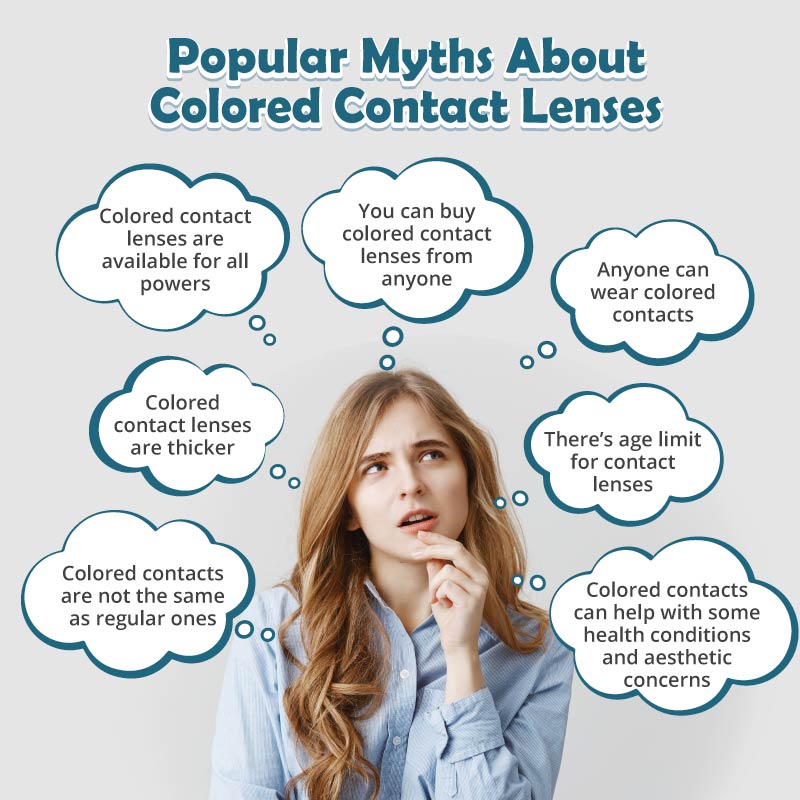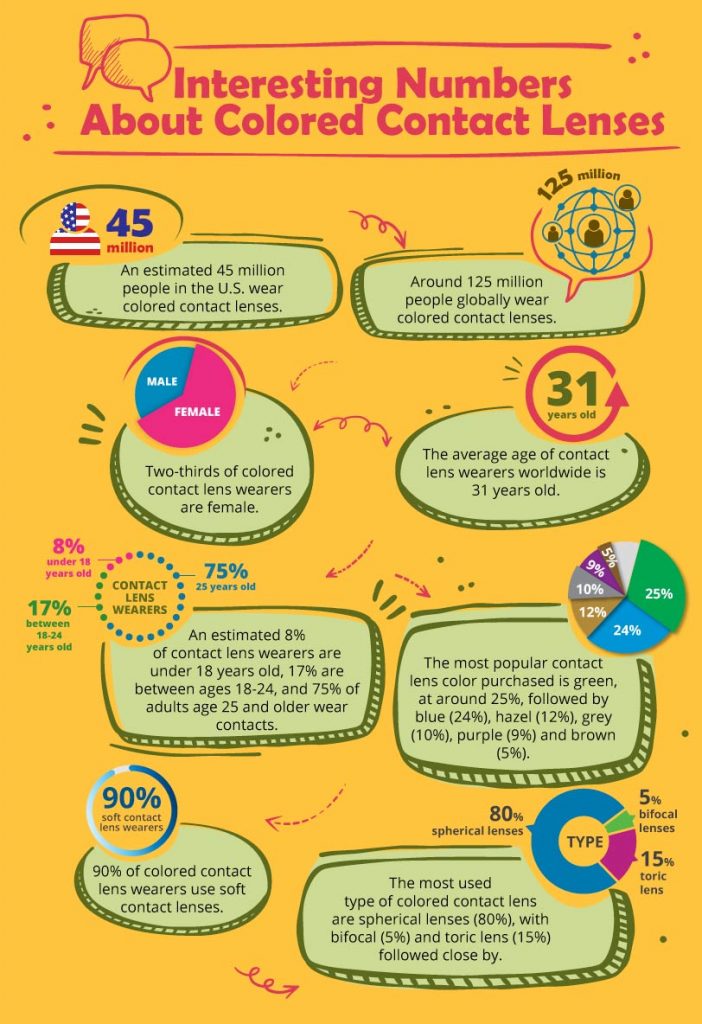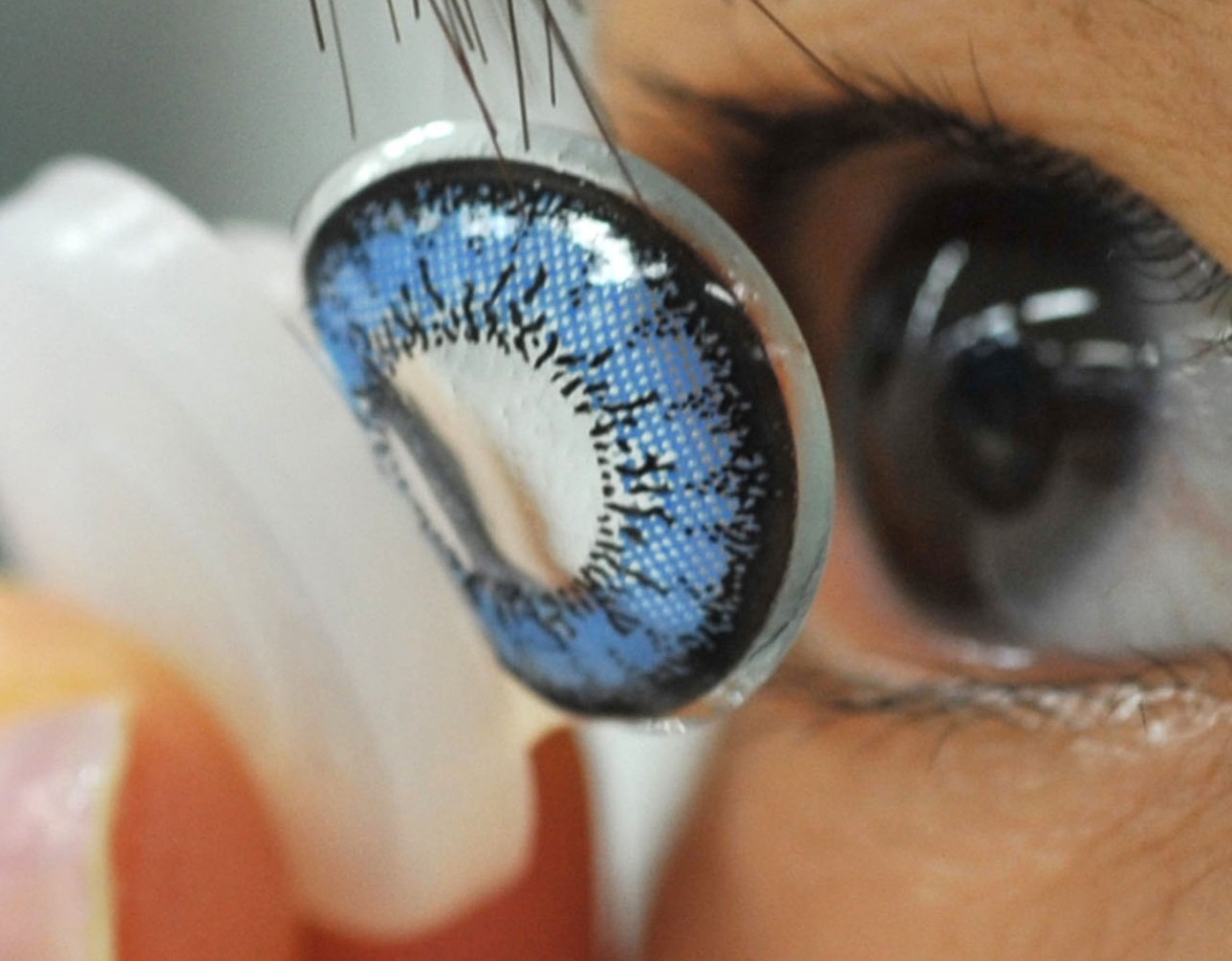When it comes to expressing yourself, it has been said that eyes are the window into the soul. If that is true, then eye colors are the soul’s curtains. One of the more popular options is the use of colored contact lenses, as they can really work to change your style with ease. Some interesting facts about colored contact lenses is that people have started using colored contacts to create a completely different persona.
In this article, we’re going over some important facts you should know about colored contacts, who invented colored contacts and how to make them work for you and add sparkle to your gaze.
Table of contents
- Who Invented Colored Contacts?
- How Colored Contact Lens Are Made?
- How Do Colour Contact Works?
- Popular Myths About Colored Contact Lenses
- 1. Colored contacts are not the same as regular ones
- 2. Colored contact lenses are thicker
- 3. Colored contact lenses are available for all powers
- 4. You can buy colored contact lenses from anyone
- 5. Anyone can wear colored contacts
- 6. There’s age limit for contact lenses
- 7. Colored contacts can help with some health conditions and aesthetic concerns
- Interesting Numbers About Colored Contact Lenses
- Conclusion
Estimated reading time: 8 minutes
Who Invented Colored Contacts?
To trace the history of colored contacts, one first needs to know the history of contact lenses in general. Although Leonardo Da Vinci is often credited with having conceived of the first ever contact lens prototype, it was not until 1887 that F.E. Muller, a German glassblower developed an eye covering that could be worn bearably.
Another interesting fact about colored contact lens is that Czech chemist Otto Wichterle finally invented the first soft contact lens which was approved by the FDA in 1971. His invention led to the discovery of colored contact lens, which forever changed contact lenses for public usage.
Read More: When Were Colored Contacts Invented?
Today, a wide variety of colored contact lenses are available for purchase for prescription or cosmetic use. Each color has its own depth and beauty, and the existence of colored lenses make it possible to mix and match for better looks.
How Colored Contact Lens Are Made?
The Sandwich Method
Introducing the sandwich method, a manufacturing method used for colored lenses.

Thus, this is why colored lenses are typically thicker than your clear lenses. With the tinted part placed in between 2 layers of clear lens, its purpose is to protect the eyes with direct contact with the biological compatible dyes.
How Do Colour Contact Works?
Colored contact lenses, like every other type of contact lens, have to be approved by the Food and Drug Administration (FDA). Hence, you definitely should not be purchasing your colored contact lenses off the street, online or any source of channel that is not linked to any licensed healthcare personnel. One may wonder why.
Just like any organs in your body, you only have one pair of eyes and you should avoid risking them. Therefore, before purchasing your colored lenses, it is highly advisable to get them prescribed. This is irregardless of whether or not you are new or a seasoned clear contact lens user.
Here’s some good news for you. Whether or not your vision is impaired or perfect, everyone and I mean ANYONE, can enjoy the luxury of being a colored contact lens user.
However, before becoming a colored lens user, first, you will need to understand how it works. It is important to ensure your eyes are compatible with your choice of lens. Understandably, you may not find a reason to do another prescription as you might be an avid lens user. Despite this, you should know that colored lenses can lead to a slight discomfort in the eyes comparing to your daily clear lens. So, how does it work and why is that so?
The Mechanism Of Contact Lens
Contact lenses of any types works by bending light passing through your vision bringing focus directly to the retina. Informations are then gathered from what you have seen, sending signals to the brain. Just like wearing eyeglasses, the manipulation of light in this method is known as refraction.

While eyeglasses and contact lens uses refraction, contact lens brings better benefits when it comes to eyesight correction. The proximity of lens with the retina changes the direction of light causing the retina to focus on a single focal point. In short, wearing lenses help fine-tune the light directing into your eyes. Wearing contact lenses means giving direct contact to your retina. This also means giving allowance to the perfect vision wherever you look providing you with an excellent peripheral vision.
Choosing Your Choice of Lens Wisely
Just like clear lenses, colored lenses also come in different sizes with different brands. Finding the correct size is important when wearing colored lenses especially.
As colored contact lens are made to mimic the natural look of your iris, it may affect your vision if they are not well fitted. So, how to know if it is a perfect fit to your eyes? Put it on and make sure your lenses are centred properly to your pupils, then make sure to look around and ensure your vision is cleared !
The centre of an opaque colored lens is usually clear to provide a crystal clear vision. However, your pupil gets bigger at night and may extend into the colored area of the lens causing a blurry vision.
Hence, it is very important to make sure the colored lenses that you purchase fits your eyes perfectly. As mentioned earlier, different brands come with different diameters and designs. Do take note that if putting them on makes your vision uncomfortable. It is advisable to take them off and visit your nearest optometrist or eye doctor immediately.
Popular Myths About Colored Contact Lenses

1. Colored contacts are not the same as regular ones
There’s nothing different about these two contact lenses, other than the fact that they’re colored. If you regularly wear contact lenses, you’ll be fine with colored contact lenses as well.
2. Colored contact lenses are thicker
Colored lenses can be a bit thicker than regular ones so need a little getting used to, which means that even regular contact lens wearers complain of a little discomfort initially. On the plus side, thicker lenses are easier to insert and remove.
3. Colored contact lenses are available for all powers
You can try colored contacts even if you have perfect vision. Color contacts are available in a wide range of powers from +6 to -8, including zero power. But the only real way to know your vision and make sure your eyes are in good shape is to first consult an ophthalmologist before selecting colored lenses.
4. You can buy colored contact lenses from anyone
Contact lenses are serious medical devices that can potentially damage your eyes. It’s always a good idea to buy your lenses from an authorized retailer. Don’t pick up lenses from just about anywhere because they’re cheap; your eyes are at stake!
5. Anyone can wear colored contacts
Even if you wear regular lenses, or have astigmatism, you can still wear colored contact lenses. However, it’s still better to check with your eye doctor on the best kind of colored contact lenses for you.
6. There’s age limit for contact lenses
While your prescription can become more complex as you age, contact lenses can correct the majority of prescriptions that spectacles can, even if you start to need help at both distance and near. Similarly, colored contact lenses also come in prescription strength.
Find out the appropriate age children can start wearing contact lenses.
7. Colored contacts can help with some health conditions and aesthetic concerns
Specialty tinted lenses can cosmetically improve the appearance of eyes disfigured by injury, infection or scarring on the cornea. Plus, there is a custom tinting process available to match the tint to the patient’s eye color.
Check out the ultimate guide to buying colored contact lenses online
Interesting Numbers About Colored Contact Lenses

- An estimated 45 million people in the U.S. wear colored contact lenses .
- Around 125 million people globally wear colored contact lenses.
- Two-thirds of colored contact lens wearers are female .
- The average age of contact lens wearers worldwide is 31 years old .
- An estimated 8% of contact lens wearers are under 18 years old, 17% are between ages 18-24, and 75% of adults age 25 and older wear contacts .
- The most popular contact lens color purchased is green, at around 25%, followed by blue (24%), hazel (12%), grey (10%), purple (9%) and brown (5%).
- 90% of colored contact lens wearers use soft contact lenses.
- The most used type of colored contact lens are spherical lenses (80%), with bifocal (5%) and toric lens (15%) followed close by.
Conclusion
With a little color in your contact lenses, you can give your eyes a makeover. The great thing about colored lenses is you have the freedom to wear them when you want, depending on your mood.
We hope these contact lens facts can help you choose your next pair of lenses. Remember, think of these lenses like you would any other type of corrective contacts and only go to your eye doctor for a proper prescription.
Browse through the many choices at Uniqso and brighten up your look with some sparkle in your eyes.
Related Articles


